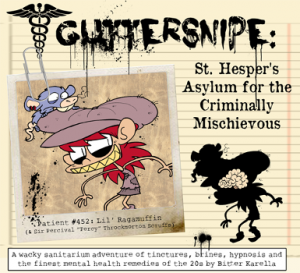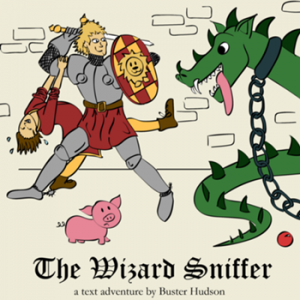 This game lives up to the expectation set by the professional quality cover art. Fun writing style and a slick in-game map feature wowed me. Lil’ Ragamuffin is a vibrant character, although not one I would let anywhere near my valuables. The period setting of the piece and her dialect give this work a strong voice. I had a little difficulty with some of the puzzles and had to peek at the walkthrough to get the phrasing right, but overall had a lot of fun.
This game lives up to the expectation set by the professional quality cover art. Fun writing style and a slick in-game map feature wowed me. Lil’ Ragamuffin is a vibrant character, although not one I would let anywhere near my valuables. The period setting of the piece and her dialect give this work a strong voice. I had a little difficulty with some of the puzzles and had to peek at the walkthrough to get the phrasing right, but overall had a lot of fun.
Having played some of the other Quest games in the comp, I had my doubts about the system when I came to this game, but now realize that it’s not so much the tool as how you use it. I did not make extensive use of items in the right column lists, but I did find them useful to indicate which items in a scene were implemented as game objects and as a reminder of what I had in inventory.
Out of habit, I spent most of my time on the command line. I wasn’t sure when I started playing this game what the convention would be for verbs linked to objects. At first, I thought that maybe all necessary verbs would be displayed in the drop down list for hyperlinks or in the buttons for objects listed in the right column. Most objects had associated verbs like “look at” or “drop”. It soon became clear that this list is not exhaustive and that the game could not be played mouse-only; some actions need to be typed in the command box. I could imagine implementing stories without requiring text entry, but I think that constraint would hobble the author and make it unnecessarily difficult to develop a game as rich as this one.
The zoomable map is the cat’s pajamas, bee’s knees, and duck’s guts. I was continuously oriented with regard to available directions, which removed the burden for both author and player of listing every exit. Unlike the compass rose display, the map gives a view of possible movement more than one turn away, so it allows more strategic movement. Using the map’s ability to scale, it was obvious after a bit of exploring what areas were inaccessible in this game.
One suggestion I would have for this mechanic — and this might be a matter of personal taste — would be to have some sort of graphic to distinguish directions that lie open versus those that are barred by some sort of impediment, be it a nasty cat, a cranky dezhurnaya, or a fingerprint scanner. I’d propose a red bar across the connecting line. I’m not sure if this is something an author would have control over within the authoring tool, or if it would require some sort of tinkering under the hood.
[Some spoilers follow beyond this point]
Continue reading “Review – Guttersnipe: St. Hesper’s Asylum for the Criminally Mischievous”
 I played with this game for about a half hour trying to get the hang of it, and while I like the premise of changing the elemental nature of items to alter their function, and while I appreciate all the innovation that went into both writing the puzzles and coding the game system, I just could not get into this game.
I played with this game for about a half hour trying to get the hang of it, and while I like the premise of changing the elemental nature of items to alter their function, and while I appreciate all the innovation that went into both writing the puzzles and coding the game system, I just could not get into this game.







